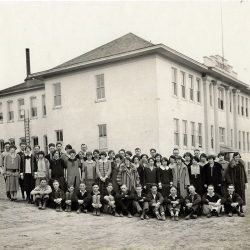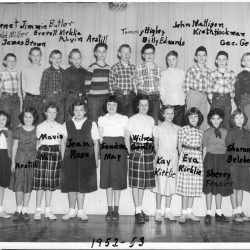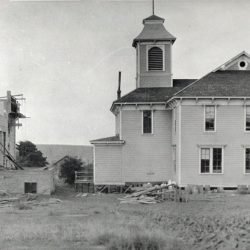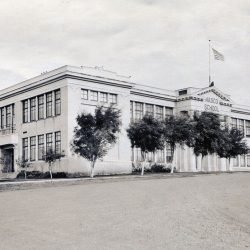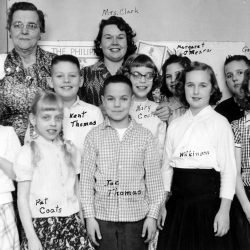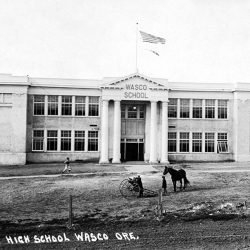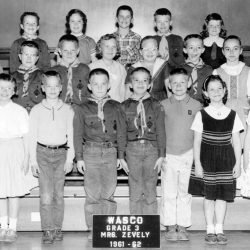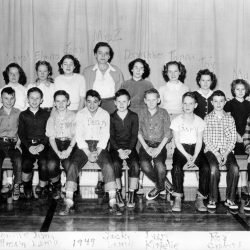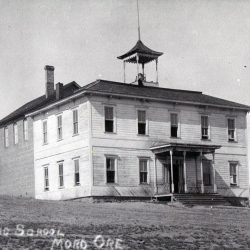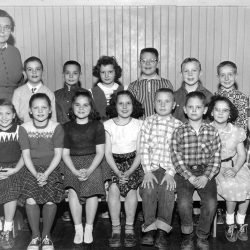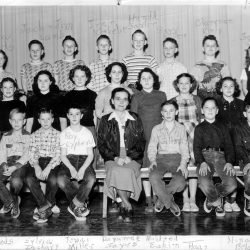The Sherman County Historical Society published stories and photographs of some early schools in the twice-yearly historical anthology, Sherman County: For The Record. At one time, 43 school districts served rural and town youngsters! A few were physically moved as the rural population changed. As roads and transportation improved, country school districts merged until there were school districts for each town, and finally merged into one district.
| Barzee School | Old-timers reported that Barzee School was about one mile N of the present Pinkerton ranch on Sawtooth Road, NW of Moro. Listed in 1900 Sherman County Voters Register, Wasco Precinct, are: Charles Barzee 41, L.F. Barzee 25, Roy Barzee 23 and W.S. Barzee 48, all farmers. ~Grace (May) Zevely; Eileen Donnell; Sanders, 1900 Sherman County Voters Register. |
| Biggs School | When Lucius Clark started school at Biggs the schoolroom was in or near one end of a grain warehouse. Hoffman, White, McDonald, Berrian and Clark children attended. Biggs School and Sacred Heart Academy were one and the same, and the building was at Biggs. It was moved up Spanish Hollow about 1.5 miles around the corner from the first Dinty’s establishment. To be nearer the pupils it was moved down the canyon to Biggs in 1902. ~Grace (May) Zevely; Belshe, They Paved the Way, 1976; SC: FTR 12-1; TO, August 29, 1902; Wasco and Sherman County Directory 1898. |
| Biglow School | Biglow School, District 1, with schoolhouse and a teacherage, was located in the extreme SW corner of the NE quarter of T2N, R18E, NE of Wasco at the head of Biglow Canyon. The Biglow District was organized in 1886, and the Early School District was taken from Biglow, then Emigrant School District formed from part of Biglow in 1915. Biglow School closed in 1929 and students went to Wasco. James Weir bequeathed property for education in this district. ~ASC 1934; Grace (May) Zevely, Moro, OR, personal scrapbooks; Patricia (French) Moore, 1982 Field notes with Ken Fridley & Gordon Hilderbrand; Belshe, They Paved the Way, 1976. |
| Blue School | The Blue School sat on the bench overlooking the Columbia River between Fulton Canyon and Biggs, serving youngsters from Biggs to Miller and a short distance south. ~SC:FTR. |
| Blue School | By 1898, the Blue School stood at the intersection of Liberty Road and Highway 97 about two miles N of Kent Cemetery. The building was moved to a canyon where Bill Guyton lived and made into a house that became the Jay McKay home. ~ Zevely, personal scrapbooks; Belshe; Big Sky map, 1974; Cora B. Guyton. |
| Boardman School | Boardman School was built about 1890 in the extreme SE corner of the SE quarter of section 10, T2S, R17E on the Milt Damon farm. School and Sunday school classes were taught there for the Damon, Hennagin, Bloomer, Bradley, Miller, Ward, Fraser, Kenny, Thogerson, Fuller and Christianson children. Remains of the foundation are visible along the road. Merle Miller purchased the building in the mid-1950s for use in enlarging his home in Grass Valley Canyon. Goodrich D. Boardman settled in the County in 1883. His farm was in T2S, R17E. ~ASC 1913; ASC 1934; Grace (May) Zevely; Bertha Belshe; SC: FTR 12-1; USGS Moro Quadrangle. |
| Brock School | Named for early settlers, the Brock School was built between 1886 and 1891 3.5 miles SE of Rufus near the Herin place. The school house was used for Sunday school with an itinerant minister. Several Brocks settled in the county as early as 1884: Russell W. Brock and family, Judge George W. Brock in Moro, Mary Brock who married G. Reed Hulse, Minnie Brock who married Russell W. Brock, Jr., Samuel J. Brock who married Lena Belle Spoon, Charles W. Brock, Flora Brock who married Jacob Brock, and Ella Brock, wife of John Galley Medler. The school district merged with that of Rufus. Listed in the 1900 Sherman County Voters Register, Wasco Precinct, are R.W. Brock 71 and V.C. Brock, editor, 40. ~SC: FTR 11-1; Grace (May) Zevely; Illustrated History of Central Oregon, 1905; SCJ, April 20, 1934; Sanders, 1900 Voters Register; Department of Interior, Lower Deschutes River Public Lands Map; SCJ, February 10, 1950; Letter from the Secretary of the Interior Transmitting a Report on the Claims of Settlers in Sherman County, Oreg., 1904; Chet Coats; Pat Macnab; Patricia (French) Moore, 1982 Field notes with Ken Fridley & Gordon Hilderbrand. |
| Buckley School | Buckley School District #33 operated a school in the NE corner of the NE quarter of section 3, T4S, R15E. Named for rancher Charles Buckley, the first schoolhouse was built on property near Lemley and Clodfelter. The second was constructed on the main road on property donated by Bill Jackson and is still standing. Buckley served Coon, Hughes, Wray, Huffman, Buckley, Zobel, Clodfelter, Munger and Hammond families. Students from the Buckley and Sherar districts were bused to Grass Valley beginning the fall of 1929 and the schoolhouse was used to house bus drivers. The first and older building was moved to that site and used for some time for grange meetings. ~Zevely; Belshe; Illustrated History of Central Oregon, 1905. |
| China Hollow School | The school in China Hollow was the first public school and first school district in the county. A school was built in 1881 just below Scott Canyon Road and over the years served Price, Eaton, Medler, Gerking, Soules, Gibson, Laughter, Dunlap, Richelderfer, Peugh, Bunnell, Belshee, Hull and Grebe children. The second schoolhouse was built further down the Hollow, but above the Andrews house. In 1897 a new school was built immediately down the Hollow from the Andrews house. It closed in 1917. The county’s first Christmas program was held in the China Hollow School. The first religious service in the Wasco vicinity was held here by Rev. Skipworth of Goldendale. The first services in Wasco were held in the hall over the Barnett store by Rev. Roe of Goldendale. ~J.A. Elder, Wasco News, 27 July 1928; Zevely; Belshe; SC: FTR 6-2, 9-1. |
| DeMoss School | DeMoss School in District 13 was first built near the present DeMoss Family Cemetery about 1885, then moved to the present DeMoss Springs Park site at DeMoss Springs about 1888. When the Columbia Southern Railroad was constructed in 1898 the school was moved to make way for the track. It served Byers, Christianson, Woods, McLachlan, Walker, Dillinger, DeMoss, Ogle and May children. A new schoolhouse was built about 1909 and was torn down by Curly DeMoss in 1960. ~Belshe, They Paved the Way, 1976; Grace (May) Zevely; Julia (Woods) Hansen. |
| Dobie Point School | Dobie Point School was located near the end of Dobie Point Road on Adobe Point NE of Kent. Garfield School, District 8, was eight miles from Kent. The schoolhouse was built in 1906 by D.M. Garfield at a cost of $382 and had a ridge roof, small belfry without a bell and a small entry. In 1907 the district became Dobie Point School, District 35, and was consolidated with the Kent district in the early 1930s. The small Garfield building was moved to the Bob Brown place. The Dobie Point School material was used to build a hangar on the George Wilson place. ~Grace (May) Zevely; Belshe, They Paved the Way, 1976. |
| Early School | Early School, District 44, was built 1887-1888 in the hamlet of Early [where vegetables and fruit ripened earliest], right on the N boundary of section 4, T2N, R18E, and was sometimes called John Day School. It served youngsters from both sides of the John Day River: Fox, Osborne, Porter, Wall, Matney, Lester, Happold, Medler, Witchey, Philippi and Fehrenbacher. A swinging bridge was built for the Gilliam County students. It was destroyed by ice in 1924. Julia Woods was the first teacher with over 30 students. When the school was closed in 1924, Fox bought the building and moved it. ~Zevely; Belshe; ASC 1913; ASC 1934; Pat Macnab. |
| Eaton’s School | A.J. Price reported that the first school in the county was taught in the Eaton home. ~Grace (May) Zevely. |
| Emigrant School | Emigrant School, District 4, was located about a half-mile S of the Oregon Trail in the extreme SE corner of the NW quarter of section 27, T2N, R18E. The site sometimes called Emigrant Springs School included the schoolhouse with a bell tower, a barn, woodshed, two outhouses, and a cave where the boys went to smoke! The school was moved to Wasco where it was remodeled for use as a residence. ~Bertha Belshe; ASC 1934; Patricia (French) Moore, 1982 Field notes with Ken Fridley & Gordon Hilderbrand; Pat Macnab; Grace (May) Zevely. |
| Erskine School | Erskine School, District 16, was located in the SE corner of the SW quarter of section 26, T1S, R16E on the N edge of Erskine and W side of the road by 1887. The first building was part of the hamlet of Erskineville by 1887. The second building was probably built in the early 1920s, with a concrete retaining wall topped by an iron fence. It was the only school in the county with real slate blackboards. Water was carried from the Erskine family well. Students came from Messinger, Thompson, Kaseberg, Brisbine, Lockhart, Meloy, Sayrs, Powell, Hunter, Bell and Luttrell families. When Erskine School closed in 1934, the buildings were sold to Roy J. Baker for one of his farms E of Grass Valley. Consolidation with the Moro District occurred in 1940. ~Bertha Belshe, They Paved the Way, 1976; Grace (May) Zevely, Moro, OR. |
| Fairview School
|
The first school in the district was located near Willerton Springs in Hay Canyon and called Hay Canyon School. This building was moved to the present site of Fairview School after the Hay Canyon homesteaders moved away. This first building was used until 1915 and sold to the Nichols family in 1916. Fairview School, District 21, was formed in 1891, located at the center of the E boundary line of section 9, T1S, R18E, beside the road. The second building was completed in 1916, and is still standing in 2003. Students came from Thompson, Rasmussen, Todd, McDonald, Sagawe, Nichols, Morgan, Gillette, Burres, Ruggles, Neal, Dillinger, Ross, Conlee, Wright and Melzer families. The earliest known records are for 1889, and the last known classes were held in 1934. ~ASC 1913; ASC 1934; Belshe; Zevely. |
| Fredburg School | The Fredburg place was on Starvation Point near Gorman. In 1898, John Fredburg farmed 240 acres in Biglow Precinct. ~Wasco and Sherman County Directory 1898. |
| Garfield School | Garfield School in District 8 was eight miles from Kent. The schoolhouse was built about 1905 or 1906 by D.M. Garfield and/or Mr. Graham at a cost of $382 on land donated by Lawrence and Sally Amick. Amick, LaChance, Daugherty, Whitney, Hart, Hansen, Newcomb, Schilling, O’Sullivan, Cochran and Stillwell children attended. In 1907 it became the Dobie Point School, District 35, and was consolidated with the Kent district in the early 1930s. The Garfield building was sold to Bob Brown and moved to his farm. The Dobie Point School material was used to build a hangar on the George Wilson place. ~Zevely; Belshe; SC: FTR 9-2. |
| Gordon Ridge School | Gordon Ridge School, District 15, was located W of Gordon Ridge Road, SE of Gordon Butte and in the extreme NE corner of section 28, T1N, R16E on the S side of the road on land owned at the time by T.W. Alley. Built about 1915, it served May, Epperson, McDermid, Moretz, Smith, Hanson, Proudfoot, Watkins and Bennett families. At one time, with only three pupils and all of them McDermids, the teacher, Naomi (Young) Van Gilder, taught in a little house on the McDermid ranch. When no longer needed, Gordon Ridge schoolhouse was moved to the Alley farm and used as a house. ~Belshe; Zevely; Malcolm McDermid; Big Sky map 1974. |
| Gorman School, District 11 | The first Gorman school was in the center of section 6, T1S, R19E on Starvation Point. Moved to the S side of the base line in the extreme NE corner of section 6, it was a one-room building with a pot-bellied coal or wood stove in the middle of the room. Water was hauled to the cistern on the site. Two toilet facilities and a barn in which to stable the students’ horses and ponies were nearby. Orren A. Ramsey constructed the second schoolhouse, built on a concrete basement, in 1921. It had a furnace in the basement with a central heating register, two cloakrooms and water piped from the cistern to the basement. Families served included Sanders, Morrow, Burkhart, U’ren, McCoy and Cothran. The school closed in the early 1930s and both sets of buildings were sold to Iva Dams for use in building a house. ~Mabel (Cothran) White; Evelyn (Morrow) Kaseberg; H. Edwin Morrow; Bertha Belshe; Grace (May) Zevely; SC:FTR 1-2. |
| Grant School | The first school in Grant was called Villard. The second Grant school building was built about 1880 by the carpenters finishing the old McDonald Hotel. It was built on a foundation of railroad ties borrowed from the Railroad by local schoolboys, and it served for school, church, shows and public meetings until the 1894 flood. Then a new school was built closer to the bluff on higher ground and was abandoned about 1897 and youngsters went to school in Rufus. ~SC:FTR 9-l; Curt Tom; Grace (May) Zevely; Chet Coats. |
| Grass Valley School | The first Grass Valley school probably stood just behind the present Grass Valley Fire Hall, although there is differing opinion about the location, number of buildings and the disposition of the schoolhouse. The second public school was on or near the corner of Second and Market Streets. When the new brick building was built about 1904, it was large enough to house elementary and secondary students, and the Baptist Academy closed. In 1908 when Prof. Henry H. White was in charge of this school the Sherman County Track and Field Meets were started. The brick school burned in 1914 and was replaced with a two-story structure S of the present IOOF hall. Grass Valley high school students started attending school in Moro in 1940. ~Bertha Belshe; SC:FTR 1-2, 5-1; Grace (May) Zevely. |
| Harmony School District 20 | Harmony School, District 20, was on the S boundary line of section 30, T1S, R18E in the hamlet of Harmony in upper Hay Canyon. The school was a distance S of Spaulding Chapel and is sometimes mistakenly referred to by the Spaulding name. Apparently the first school here was the little unpainted Upper Hay Canyon School on the hill W of Donald Martin’s building where water was fetched from down the hill. Bruckert, Reese, Brown, Elliott, McDonald, Morgan, Duvall, Wright, Havnar, Mason, Miller, Hulse, Rose, Anderson, Fraser, Morrison, Allen, Axtell, Belshee, McFadden, Hastings, Dillinger, Henkle, Penland and Starnes children went to school at Harmony. ~ASC 1934; Bertha Belshe; Grace (May) Zevely; USGS Harmony Quadrangle. |
| Hay Canyon School / Lower Hay Canyon School | Hay Canyon School was located above Willerton Grove N of the four-way bridge, and was later moved to Fairview. Students were from the Willerton, Ginn, Elliott, Belshee, West, Morrison and McLachlan families. Harriet Nish described it as Liberty school house in Hay Canyon above the Willerton home, built in 1884 where Mattie Jory was the first teacher. The Lower Hay Canyon school was replaced by the Monkland School. ~Harriet Nish, SCO, 2 July 1937; ASC 1934; Bertha Belshe; Grace (May) Zevely. |
| Jacks School | Jacks School was a frame building constructed in the 1880s and used until 1907, named for Henry Jacks. It was replaced by the brick Klondike School built in 1907 across the road. ~Keith McCoy; Pat Macnab; French; Zevely. |
| Kelsay School | Kelsay School, E of Kent and N of the present Justesen farmstead, was in use before 1905. The 1913 atlas shows an “abandoned school” in the extreme SE corner of the SE quarter of section 12, T4S, R17E near the head of Kelsay Canyon. ~Grace (May) Zevely; ASC1913. |
| Kent School | The White School House was the precursor to the Kent School, located on property due SW of the Sather farm buildings. Will Guyton moved that building to Macken Canyon from the property of his father-in-law, John Bell. The second school was in Kent and served youngsters in grades 1 – 10. It was on the far W end of Second Street and was later used as a movie theater, then a grange hall in the late 1920s. Faye (Howell) Beyer wrote that it had two rooms, one for the grades and one for the high school. The new Kent School was built in 1916 with an auditorium on the second floor, and rooms divided into primary, middle, 7th and 8th grades and high school. The full basement had a playroom and furnace room. Families served in the earliest years included Sather, Hoskinson, Schadewitz, Young, Holmes, Lyons, Helyer, Wilson, Amick and von Borstel. The Kent gymnasium, a separate structure, was built after World War I. ~Bertha Belshe; Grace (May) Zevely; SC: FTR 2-1; Faye (Howell) Beyer; Gertrude Buether; Marie Hattrup. |
| Klondike School, District 30 | Klondike School, the only brick country school in the county, was constructed on the John A. and Fanny (Hilderbrand) Walter holdings about a half-mile E of Klondike on the N side of the road, section 7, T1N, R18E. George Hilderbrand reportedly obtained the brick in Goldendale. Students served were Potter, Hilderbrand, Peddicord, Huck, Redman, Matthias, Walter, Sylvia, Dutton, May, Wilde and Anson. The school was last used about 1932 or 1933, and collapsed in high winds in 2003. ~ASC 1934; Pat Macnab; Bertha Belshe; Grace (May) Zevely; Gordon Hilderbrand; USGS Klondike Quadrangle. |
| Land Grant Schools | Land grants beginning in 1848, by act of Congress, provided every 16th and 36th section, or 1,280 acres of each township, public land reserved in territories and states that organized as public and school lands. In Oregon a provision was for the 36th section of land. Annual income from these lands provided support for public schools in the state. ~Corning. |
| Liberty School, District 25 | Liberty School was in the extreme NW corner of NW quarter of section 23, T4S, R16E at the head of Mule Canyon NW of Kent. Built in 1902, it was originally called the German School or the German Settlement School. The name was changed because of wartime sentiments. For the 1906-1907 school year there were 42 students enrolled. The school was in use until 1933-1934 when the district merged with Kent. Schadewitz, Wassenmiller, Koepke, Schassen, von Borstel, Patjens, Schilling, Detjen, Adams, Clark, Bibby, White, Newcomb, Orcutt, Holmes, Needham, Peters, Mitchell, Fritts, Ruggles, Gorackie, Barnett and Muir youngsters attended. The buildings were sold and some lumber was used on the George von Borstel-Arthur Holt and Carl von Borstel farms. ~Grace (May) Zevely; George and Pat von Borstel; SC: FTR 10-2; Bertha Belshe; USGS Bronx Canyon Quadrangle. |
| Lickskillet School | Lickskillet School was located at the head of Sherar’s Grade on Hwy. 216 near the intersection of Brown Road about three miles W of Buckley and about 15 miles SW of Grass Valley. The school was built about 1904 and closed during the 1930s, the building sold to Ted Ball and Bill Todd for the lumber. Its name reflects the difficulties encountered in making a living in the neighborhood. County School Superintendent Grace Zevely tried to change the name to Mountain View and the name fit, but not in the same way as Lickskillet. She was happy her efforts failed. Shipley, Rust, Stradley, Anderson, Munger, Dugger, Augee, Watson, Stowe and Leonard children went to school here. As transportation and roads improved in the 1930s, students were transported to Grass Valley. ~Grace (May) Zevely; Big Sky map 1974; Bertha Belshe; SC: FTR 13-1. |
| Locust Grove School, District 5 | Locust Grove School, District 5, was located on the N side of present-day Highway 206, in the NW quarter of section 2, T1N, R16E. Gilford D. Woodworth arrived in 1880, one of the first settlers, and took up land at present day Locust Grove in 1884. He gave the ground for the Locust Grove United Brethren Church there. The little schoolhouse across the road [Highway 206] on his homestead was about four miles W of Wasco, built by Woodworth for his and neighboring children: Van Gilder, Woods, Watkins, Porter, Simpson, Robinson, Love, Andrews, Barnett and Kaseberg. The grove was a ten-acre requirement for a Timber Culture Claim. Children attending the school helped to plant the trees on the N side of the road, each originally named for a U.S. president. ~Grace (May) Zevely; Bertha Belshe; SC: FTR 2-2; Inez (Van Gilder) Sargent. |
| Michigan School | Michigan School, District 26, was located about 7 miles SW of Grass Valley at the E boundary of section 20, T3S, R16E. The first schoolhouse was located 2 miles E of the second schoolhouse, attended by children who later went to Rosebush School. It was about 16’ x 24’ with one door and several windows. The second schoolhouse was built during WWI, larger and more substantial, 2 miles W of the 1st. It was sold to Roy J. Baker and moved to the Heath place. Named for the large number of people in the district who came W from Michigan, it served the French, Heath, Stanton, Fairchild, Blaylock, Smith, Perrault, Tiller, Hodge, Coyle, Newcomb, Rodd, Reckmann, Bain, Jones, Simpson, Dugger, Bullock, Mulkey & Kunsman families. Millard B. Taylor, a physician, married Mattie Bailey, and owned 640 acres there. ~Grace (May) Zevely; Giles L. French; Phil Hirl, 2007. |
| Middle Oregon Baptist Academy in Grass Valley | Sponsored by the Eastern Oregon Baptist Society, the Middle Oregon Baptist Academy in Grass Valley began operating in October 1895. The school offered three courses of study: classical, normal/teaching, or business. It drew students from a wide area in the region. Founded by the Middle Oregon Baptist Association, the building was 48’ x 48’, two stories with four rooms and with a full basement. It closed in 1904 and the deed quit-claimed to Alexander Scott a few years after. Excerpted from the History of the Middle Oregon Baptist Academy: “The Middle Oregon Baptist Association was organized in 1883 at the home of Bro. Thomas Badger, near the present village of DeMoss Springs, in Sherman County, Oregon, October 31st. It had three churches, three ordained ministers and 58 members. Elder S. B. Phillips was Moderator; J. B. Wheat, Clerk… (it was believed that) Friendship Baptist Church of Moro, Kingsley Baptist Church of Kingsley, and Shutler Flat Baptist Church were the three churches, all of which have long been extinct, but they did their part in their time.” ~SC: FTR 1-1; French; Grace (May) Zevely; Matoon’s Baptist Annals of Oregon; History of the Middle Oregon Baptist Academy. |
| Miller School, District 37 | Miller School, in the hamlet of Miller, was located on the bench above the Columbia and Deschutes Rivers with a fine view of the freight and passenger trains, hand cars, section crews at work and cattle fording the river to Miller Island. Completed in 1912, it served Miller, Carlisle, Vogel, Stiles, Spencer and Olson families and a few families in Wasco County. Leonard Jordan drove the school bus for 37 years, transporting students from Celilo, Miller and Big Eddy to school in The Dalles. When Miller consolidated with Rufus School District, he transported students from Biggs and Miller. ~SC:FTR 1-2; Grace (May) Zevely; Curt Tom; Arden Jordan; Anna (Olson) Jacobsen; USGS Wishram Quadrangle. |
| Monkland School, District 19 | Monkland School was located in the extreme SW corner of the SE quarter of section 1, T1S, R17E, about 1.5 miles N of the hamlet of Monkland. The first school building at this site was built by 1885 and used until 1914. Mr. Grimes built the second school about 1914, with a belfry, a large bell, woodshed, small stable and a teacherage. It closed in the early 1930s. School picnics were held at Willerton Springs in Willerton Grove over the hill in Hay Canyon. Families served included: Axtell, Belshe, Belshee, Elcock, Gillette, Gosch, Kenny, May, McDonald, McKinney, McLachlan, Woods, Melzer, Morrison, Mortenson, Nish, Rasmussen, Ruggles, Thompson and White. In 1918 Mrs. M. Mortenson, Ira K. Axtell, W.A. Ruggles and C.J. Thompson were on the school board. The school closed in the early 1930s and the district consolidated with Moro about 1940. The building was sold to Bob Belshe who used it to build a shop. ~ASC 1913; ASC 1934; Bertha Belshe; Grace (May) Zevely; Margaret (McLachlan) Woods; Mollie (Robinson) McLachlan; Julia (Woods) Hansen. |
| Moro School | The first schoolhouse in Moro, District 17, was a small, unpainted one-room building on Main Street near the Baptist Church. It was incorporated into the house next to that site once owned by Ralph and Havie Brisbine on Highway 97. The second school, a white, wooden four-room structure, was built in 1892. School was held in the Presbyterian church while the third school was under construction. In September 1902, William A. Raymond was employed to build an annex to the Moro High School building, 22’ x 33’, for $2,020. In 1912 Moro qualified to include a standard high school. ~Bertha Belshe; Grace (May) Zevely; SC:FTR 3-1; History of Central Oregon, 1905; Donalda Knighten. |
| Neece School | The Neece School was named for the pioneer Neece families and was located at the intersection of the roads N of the Macnab and Van Gilder farm buildings. Built about 1913, it served Walker, Judkins, Neece, Sober, Maxwell, Hardin, Kaseberg, Simpson and Burres children. Crowded conditions there created the need for opening Barzee School. When Neece School closed, the Van Gilders bought it and moved it to the Van Gilder [Maxwell] place to construct a dwelling, and it eventually burned. T.C. Neece, 46, farmer, is listed in the 1900 Sherman County Voters Register, Wasco Precinct. ~Bertha Belshe; Grace (May) Zevely; Albert C. Kaseberg; Inez (Van Gilder) Sargent. |
| Price’s School | Jay Price grew up around the stage station at Sand Spring and Price’s Canyon, and attended the first school held in the county when his father hired a teacher for Jay and his half-brother Martyn Masiker during the winter of 1872-1873. The boys later went to school with the Eaton children. ~Carson C. Masiker; A.J. Price, SCJ; Giles L. French, The Golden Land; Inez (Van Gilder) Sargent. |
| Rosebush School District 32 | Rosebush School was located on the N boundary line of section 20, T3S, R17E on the S side of the road near Bourbon. It was probably named for wild roses growing nearby. The school served the Peters, Taylor, Stark, Tillson, Bell, Lemon, Eslinger, Peterson, Koepke, Blaylock and Sather families. Some old-timers stated it was built about 1890, was still standing in the 1960s, and consolidated with Grass Valley School District in the early 1930s. ~Grace (May) Zevely; ASC 1913; ASC 1934. |
| Rufus School, District 3 | The first Rufus School was up the draw from the town, a one-room building built by 1892 when the students included Morris, Fowler, Fine, Wallis, Munson, Linderman and Ruggles children. District directors in 1899 were W.A. Wallis and H. Christman with J.S. Amos, clerk. A two-room school was built about 1907 and served the community for about 20 years. When the present school was built about 1928, the second school building was sold to the Rufus Grange #826, and continues in use. The school building is no longer part of the Sherman County School District. The location is the N boundary of section 6, T2N, R17E. ~ASC 1934; ML, 26 April 1899; SC:FTR 3-1; Grace (May) Zevely; Pat Macnab; Ray and Jean Brown; Chet Coats. |
| Rutledge School, District 24
|
Rutledge School was located on the S boundary line of the NW quarter of section 1, T3S, R17E and built in the late 1890s. Families served included Adams, Eakin, Dillinger, Marlin, Ruggles, Rutledge, Thompson and Whitman. Lena (Shelton) Searcy taught her first term there in the 1890s for $40 per month and boarded with the Rutledge family. Miss Emma Ward taught 1897-1898 and her students were Effie Bowen; Eva Belcher; Lloyd and Hazel Dunahoo; Stella, Vernie, Viola, Lizzie, Volando, John, Dellie, Clyde, Lottie, Biddle and Loretta Eakin; Fred and John Goetjen; Edgar, May, Ida, Alice, Orrin and Lester Johnson; Ned Norton; Willie O’Sullivan; Nellie, Minnie and Mary Payne; Clarence and Joe Rutledge; Oscar, Starr, Walter, Sadie and Lois Ruggles; Arthur, Hubert, Edd and Grant Smith; Edwin, Harry and Albert Van Landingham; Mabel, Edith, Nellie, Maurice, John and Albert Thompson. Directors in 1899 were T. Van Landingham, H. Smith and Thomas Callaghan, with G.E. Thompson, clerk. The school closed and the district consolidated with the Grass Valley district. In the late 1940s the school property was sold to Dean Reynolds, adjacent landowner. The school house was remodeled about 1948 for use Gene and Nadyne Reynolds’ residence. Owen Eakin purchased the property and remodeled the building again. ~Grace (May) Zevely; ML, 26 April 1899; Bertha Belshe; Emma Jean (Eakin) Smith, 2003; ASC 1913; SC: FTR 4-1. |
| Sherar’s Grade School | The Standard Atlas of Sherman County, 1913, shows a school in the NE quarter of the NW quarter of section 32, T3S, R15E on the Sherar’s Grade Road. At the time it would have served Stradley, Taylor, Jones, Stow, Johnson and Augee families. ~ASC 1913; Grace (May) Zevely. |
| Sherman High School; Sherman Junior/Senior High School | Sherman High School in Sherman County School District was built on a 15.5-acre site a short distance S of Moro, the county seat. In May 1956, county voters decided in favor of a county high school, 486 in favor, 272 opposed, and elected a new five-person board, one from each district in the County. All five favored construction of a new high school. Designed by Annand, Boone and Lei for 150 students, the gymnasium was the largest of the Eastern Oregon OR B schools. The original contract with Wall, Bartram and Sanford was for $357,000. Some wings were added later, and the gymnasium replaced after a fire. The first classes were held in January 1957. In 2003 because of serious funding reductions, the 7th and 8th grades were moved to the high school campus. ~Bertha Belshe; USGS Moro Quadrangle. |
| Upper Hay Canyon School, District 20 | Upper Hay Canyon School was at or near Harmony in Upper Hay Canyon. ~Grace (May) Zevely; Bertha Belshe; Walt and Helen Bruckert; Margaret (McLachlan) Woods, Dufur, OR. |
| Villard School | A school was located at Villard [Grant] in the early 1870s. Conducted in a two-story building built for surveyors, it first operated as a three-month school. ~SC:FTR 9-1. |
| Schools, Wasco School | The first school in Wasco was a one-story structure built about 1888 and used for two years. The second, with four rooms, was built in 1890 for $4,000. The third and present building was built in 1916 next to the second that was dismantled. A teacherage was built in 1917. ~Grace (May) Zevely; Inez (Van Gilder) Sargent. |
| Webfoot School, District 10 | Webfoot School was built in 1894 in the extreme NW corner of the SW quarter of section 12, T1N, R18E, due E of Klondike. The school standing in 2003 is probably the second structure. The school served Allen, Dunn, Elrod, Ferrell, James, McDonald and Potter families. Klondike Grange members met in this building. ~Bertha Belshe; ASC 1934; Helen Bruckert, Wasco, OR; Grace (May) Zevely; USGS Klondike Quadrangle. |
| Weir District; Weir Charitable Trust | James Weir owned 920 acres in Biglow District and 480 acres in Emigrant District, left in trust for the education of children of these two school districts. When he died in 1907 he willed $2000 to the City of Wasco for a metal fountain. The two Weir charitable trusts continue to provide important opportunities for students. ~Pat Macnab. |
| Wheat School | The first Wheat School was W of Grass Valley Canyon where the old roadbed entered the creek on the Douma farm W of Moro. It was moved to a site S of the Orlow Martin house, about 100 yards N of the Lloyd Henrichs buildings on the E side of the road on then McCallum land. School was in session three months each fall and spring as early as 1894, serving Martin, Belshe, McGinnis, Rose, Fuller, Strong, Patterson, Anderson and Hulse families. Jacob Boone Wheat, a Civil War veteran, came from Lawrence County, MO in 1880 and lived three miles SE of Moro with his wife Charlotte T. (Neece) and their children, Henrietta, Nathaniel P., Edwin Boone and Don Carlos. See Nat Wheat Canyon. ~Illustrated History of Central Oregon, 1905; Bertha Belshe; Grace (May) Zevely; TO, 23 December 1910; H. Edwin Morrow; Joe Morrow; Gladys (Morrow) Laidlaw; Dorothy Kreutz. |
| White School | The first school in the Kent region was the White School about a half-mile S-SW of the Sather farm buildings and two miles S of Kent. It is likely that it was named for Professor Henry Harrison White who taught there. White, educated at the US Naval Academy, married Cora Hudson and their children included Helen who married Walt Bruckert, James Hudson, Harold who married Adria Yancey, Alice Louise who married Roy J. Justesen in 1929 and Lillian who married a Bogardus. Will Guyton moved the large white building to Macken Canyon from the property of his father-in-law, John Bell. ~Donald von Borstel; Bertha Belshe; Big Sky map, 1974; Helen (White) Bruckert; Grace (May) Zevely; SCJ, October 1980; GVJ, 1907; SC: FTR 4-2. |
| Wilcox School, District 29 | Wilcox School was built two miles E of Wilcox rail station and six or seven miles SE of Kent about 1909, originally built to accommodate only two families in T5S, R18E, the Harvey Duckworths in section 30 and the Charlie Guytons in section 20. As land filled up, the building was moved in 1915 to about one mile S of Wilcox Station along the railroad track, T5S, R17E, a more central location for area families. An entrance hall, flag pole and cloak room were added, a jacket put around the stove and single desks installed to serve Duckworth, Guyton, Strong, Adams, Helyer and Edwards children. Sunday School classes were conducted under direction of the Sunday School Superintendent Mrs. Ada Guyton and Secretary Elmira Edwards. After consolidation with Kent in 1932, the building was sold to the Helyers and used to build a house. ~Bertha Belshe, They Paved the Way, 1976; Grace (May) Zevely. |
Tumbling Team in Branded Uniforms
~ Sherman County Journal, April 28, 1950
Members of the first and second grade tumbling team of Moro’s elementary school are no longer ‘dogies.’ Sporting livestock brands in place of numbers which ordinarily appear on athletic clothing, the midget performers boast shiny nylon uniforms which their mothers made from aerial tow targets obtained from surplus military property.
Boys are decked out in black trousers style one-piece suits while the girls proudly display white bloomer style uniforms. Contrasting materials bordered with orange thread sewn on a Necchi machine by Mrs. (Afton) McIntyre of Wasco produced brands that can be read from a considerable distance.
Stressing participation of every member of the two classes instead of perfection by a few individuals, Mr. Kenneth Young, superintendent, and Mrs. Jeanette Yocom, primary teacher, have sponsored several public appearances to the delight of audiences. Educational benefits derived from this phase of physical education include strengthening of all parts of the body, development of coordination and gaining self confidence.
Many youngsters wear the insignia of parents, grandparents or other relatives. Some sport the mark of personal friends. Still other children whose ancestors were not ranchers carry brands of important livestock operators in the past. Lana Jean Paulson, daughter of the local barber, appropriately displays the scissors emblem of the Harper family of Wasco. Your editor’s (Giles French) own brand which was used some decades ago in the south end of the county spells the owners name with the F-Wrench insignia. The Lane family brand includes all letters of the name.
Young, one of whose hobbies is collecting information about brands, states he has heard stories of stockmen using brands to decorate livestock, sign posts, wagons, harness, riding gear, jewelry and many other possessions. A few over-possessive hombres extended the practice of positive identification to the bodies of their wives. However, the Moro experiment is the only instance he knows about where brands are used to decorate the most significant product of any ranch home, the boys and girls who will repopulate the ranges and preserve the heritage of the past.
The tumbling team roster included: Stephen Haase, Bobby Cyphers, Tommy DeMoss, Walter Nichols, Bobby Archer, Roy Looney, Curtis Kayse, Philip Gilman, Terry Butler, David Conlee, Alan Miller, Gary Thompson, Fred Joy, Mike Zachary, Arlene DeMoss, Darlene Miller, Vicky Lane, Joyce Edwards, Ronda Fraser, Diana Henrichs, Lana Jean Paulson, Sharon Blum, Mary Higley, Janet Thompson, Nancy Gearhart and Julie Woods.
Sherman County News: June 7, 1928: “On Friday, June first, the commencement exercises were held in the school auditorium [Moro] for the senior class. The stage was decorated with light green branches and sprigs. The effect was very pleasing. There are ten graduates, seven girls and three boys, who are: Edith Dillinger, Norma Powell, Julia Sagawe, Evelyn Christianson, Velma Powell, Faye Thompson, Henrietta Akers, Ethan Woods, Howard Ross and Clarence Huls. An interesting and appropriate address was given by R.R. Butler, the speaker of the evening, and presentation of diplomas by W.C. Bryant. Further entertainment was tendered by Misses Mitchell and Ingelis. A special feature was offered as a duet by Mrs. Holleway and Miss McIntyre. An unusually large crowd was present at the exercises.”

